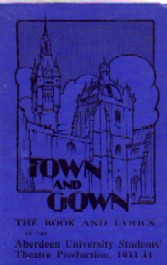In 1933, Student Show returned to HMT in style.
It had been decided to attempt a spectacular production along the line of Noel Coward’s “Cavalcade” which had been a recent success in London.
The result was ‘Town and Gown’, written and directed by Douglas S. Raitt. It presented a ‘magnificent pageant’ of Aberdeen, depicting notable incidents in the history of both the Burgh and the University from the time of Bishop Elphinstone onwards. The show’s subtitle was ‘a medley of fact and fiction concerning Aberdeen and its university’. It featured a cast of 120 people.
The script and lyrics were published in 1933, together with the original music of two of the songs.
The author, Dr Douglas S. Raitt, was a marine biologist who worked in the Marine Laboratory in Torry, with several scientific papers published. It may have been his employment in the civil service that made him shy away from revealing his real identity when he appeared as popular radio performer ‘Rab The Rhymer’, singing and playing piano in broadcasts from the BBC Aberdeen Studios.
Another memory of the ‘Town And Gown’ era came from former Show conductor Roderick MacLean, who wrote the following piece 23 years later :
“You mustn’t misunderstand me when I say I’m glad that I don’t live in Aberdeen any longer.
If I did, each Easter vacation would find me dropping in to steal a look at rehearsals for the student show; and each year I would feel just a bit older, and be just a bit less welcome.
As it is, I have managed to get along quite happily thinking of myself as still really belonging to the student generation, and only geographically removed from the scene of my former indiscretions.
That was the case, at least, until a letter from Gwyneth Wycherley [souvie editor] made it suddenly and painfully clear that I am now an old-timer; and with an overnight greying of the locks I realised that twenty years had passed since my first student show.
Quite honestly, I don’t think I’ve ever enjoyed anything as much as these yearly incursions into the theatre, and what I enjoyed most of all was the realisation of everyone’s ambition – to conduct an orchestra. That I managed to do in three different shows, and even now when I want to impress acquaintances (it doesn’t work with friends) I can refer casually to the time when I conducted a theatre orchestra.
But let’s be honest – it was all rather a fraud. True, one had perhaps written the tunes, so that at the first exciting rehearsal on the Sunday afternoon one could raise a disapproving eyebrow and suggest that that wasn’t quite the phrasing one had in mind. But beyond that – well, I recall one occasion when I so completely failed to make my meaning clear with either baton or facial expression that I had to leave the rostrum, bend close to the ear of an over-enthusiastic player, and shout above the general din “For any sake, man, shut up!”
Two people co-operated to give my brief career as a conductor some semblance of proficiency. One was Lambert Wilson, who led the orchestra – and me; and how tactfully he did it. The other was Dougie Raitt. Just before the curtain went up on my first “first night”, he came round to the band room and said, “Now I’ll be standing in the wings, and you’ll just be able to see my toe; if anything gets out of control, take the beat from my foot”. Sure enough, at intervals throughout the evening I could see just the tip of his white gym-shoe; and anyone who knew Dougie Raitt as a producer will remember that even the toe of his gym-shoe could speak volumes. I felt it a matter of considerable pride that from the second night onwards, the toe in the wings had disappeared.
They tell me that when the cleaners move into the theatre after a student show, to clean up the litter of call-sheets and band parts and crumpled programmes and unsold souvenirs, they always sweep up the fragments of a few broken romances as well. That was true in my young day at any rate. But most of us recovered remarkably quickly. And most of us, I suspect, hang on to some sentimental reminder of our association with the footlights. Personally, I’ve had a memento of my theatre shows knocking around the house for nearly seventeen years now. When I met her first, she was in the dancing chorus.”
Roderick MacLean, 1957
(This memoir first appeared in the 1957 Student Show souvenir programme)
After the final curtain on the Saturday night, the University Principal, Sir George Adam Smith, made arrangements with the organisers of Show to have it repeated for the benefit of the conference of the British Association for the Advancement of Science to be held in Aberdeen the following autumn. The Show committee agreed to do so. Thus in September 1934, ‘Town and Gown’ re-appeared, re-written and adapted for the occasion, but essentially the same as the 1933 production.
It was even more of a success the second time round.

